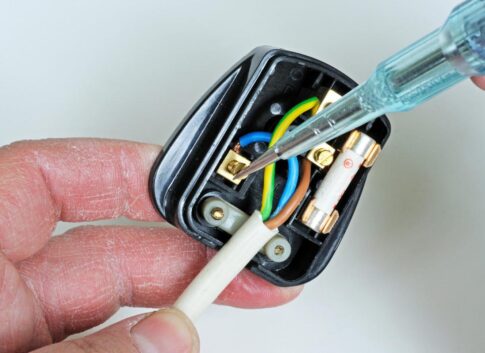
Changing a plug in the UK involves wiring a new plug onto the end of an electrical cord.
This process should be performed carefully to ensure your safety.
If you're not comfortable or experienced with electrical work, it's best to consult a professional electrician.
If you're confident in your abilities, here's a general guide on how to change a UK plug:
Materials You'll Need:
- New UK plug
- Wire cutters/strippers
- Screwdriver
- Electrical tape
- Wire connectors
Safety Precautions:
Ensure the appliance is unplugged from the power source. Make sure you're working in a well-lit and dry area. Double-check the voltage and current rating of the appliance to match the plug's specifications.
Steps:
Prepare the Plug:
Open the new plug's casing by unscrewing it using a screwdriver. Separate the top and bottom halves of the plug.
Strip the Cable:
Use wire cutters to remove the old plug from the cable by cutting it near the old plug. Strip the outer insulation of the cable (about 3-4 cm) to expose the individual wires (usually three: live, neutral, and ground).
Prepare the Wires:
Strip about 1 cm of insulation from the ends of each wire to expose the conductive metal. If the wires have frayed strands, twist them together gently to create a solid end.
Wire Connection:
Inside the plug, you'll find three terminals marked 'L', 'N', and 'E' (or 'L', 'N', and a symbol for earth). Connect the wires as follows:
- Live (Brown or Red) wire to 'L' terminal.
- Neutral (Blue or Black) wire to 'N' terminal.
- Ground (Green and Yellow) wire to 'E' or the earth symbol terminal.
Tighten the screws on each terminal to secure the wires.
Secure the Cable:
Make sure there's a cord grip (usually provided with the plug) to prevent strain on the wire connections when the cable is tugged.
Close the Plug:
Carefully close the top and bottom halves of the plug casing, ensuring that the wires aren't pinched or damaged. Tighten the screws on the casing to hold it together securely.
Insulate the Wires:
Use electrical tape to individually wrap the exposed wire ends. This prevents any accidental contact between wires.
Final Check:
Double-check that all connections are secure and no wires are exposed. Check that the correct wires are connected to the respective terminals.
Plug Test:
Before plugging the device into a power source, use a socket tester or a multimeter to verify that the wiring is correct.
Plug In:
Once you're confident that everything is correctly wired and secure, plug the device into a power source and test it. Remember, if you're unsure about any step or have concerns about your safety, it's recommended to seek assistance from a professional electrician.
Electrical work can be dangerous, and it's always better to prioritize your safety.

